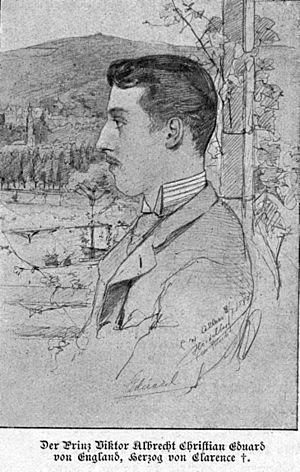Prince Albert Victor, Duke of Clarence and Avondale facts for kids
Quick facts for kids Prince Albert Victor |
|||||
|---|---|---|---|---|---|
| Duke of Clarence and Avondale | |||||
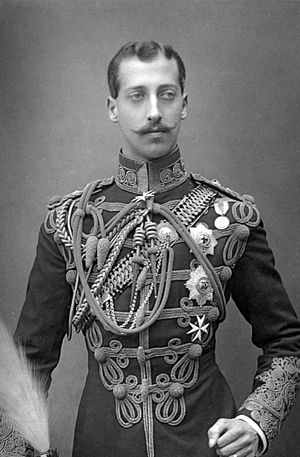
Photograph by W. & D. Downey, 1891
|
|||||
| Born | Prince Albert Victor of Wales 8 January 1864 Frogmore House, Windsor, Berkshire, England |
||||
| Died | 14 January 1892 (aged 28) Sandringham House, Norfolk, England |
||||
| Burial | 20 January 1892 Royal Vault, St George's Chapel, Windsor Castle; later moved to Albert Memorial Chapel, St George's Chapel |
||||
|
|||||
| House | Saxe-Coburg and Gotha | ||||
| Father | Albert Edward, Prince of Wales (later Edward VII) | ||||
| Mother | Alexandra of Denmark | ||||
Prince Albert Victor, Duke of Clarence and Avondale (Albert Victor Christian Edward; 8 January 1864 – 14 January 1892) was the eldest child of the Prince and Princess of Wales (later King Edward VII and Queen Alexandra) and grandson of the reigning British monarch, Queen Victoria. From the time of his birth, he was second in the line of succession to the British throne, but did not become king or Prince of Wales because he died before both his grandmother and his father.
Albert Victor was known to his family, and many later biographers, as "Eddy". When young, he travelled the world extensively as a naval cadet, and as an adult he joined the British Army but did not undertake any active military duties. After two unsuccessful courtships, he became engaged to be married to Princess Victoria Mary of Teck in late 1891. A few weeks later, he died during a major pandemic. Mary later married his younger brother, who eventually became King George V in 1910.
Contents
Early life
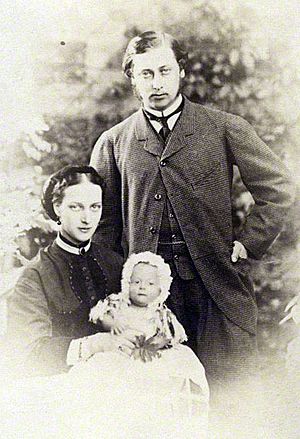
Albert Victor was born two months prematurely on 8 January 1864 at Frogmore House, Windsor, Berkshire. He was the first child of Albert Edward, Prince of Wales, and his wife Alexandra of Denmark. Following his grandmother Queen Victoria's wishes, he was named Albert Victor, after herself and her late husband, Albert. As a grandchild of the reigning British monarch in the male line and a son of the Prince of Wales, he was formally styled His Royal Highness Prince Albert Victor of Wales from birth. He was christened Albert Victor Christian Edward in the private chapel of Buckingham Palace on 10 March 1864 by the Archbishop of Canterbury, Charles Longley, but was known informally as "Eddy".
Education

When Albert Victor was just short of seventeen months old, his brother, Prince George of Wales, was born on 3 June 1865. Given the closeness in age of the two royal brothers, they were educated together. In 1871, the Queen appointed John Neale Dalton as their tutor. The two princes were given a strict programme of study, which included games and military drills as well as academic subjects. Dalton complained that Albert Victor's mind was "abnormally dormant".
Though he learned to speak Danish, progress in other languages and subjects was slow. Sir Henry Ponsonby thought that Albert Victor might have inherited his mother's deafness. Albert Victor never excelled intellectually. Possible physical explanations for Albert Victor's inattention or indolence in class include absence seizures or his premature birth, which can be associated with learning difficulties, but Lady Geraldine Somerset blamed Albert Victor's poor education on Dalton, whom she considered uninspiring.
Separating the brothers for the remainder of their education was considered, but Dalton advised the Prince of Wales against splitting them up as "Prince Albert Victor requires the stimulus of Prince George's company to induce him to work at all." In 1877, the two boys were sent to the Royal Navy's training ship, HMS Britannia. They began their studies there two months behind the other cadets as Albert Victor contracted typhoid fever, for which he was treated by Sir William Gull. Dalton accompanied them as chaplain to the ship.
In 1879, after a great deal of discussion between the Queen, the Prince of Wales, their households and the Government, the royal brothers were sent as naval cadets on a three-year world tour aboard HMS Bacchante. Albert Victor was rated midshipman on his sixteenth birthday. They toured the British Empire, accompanied by Dalton, visiting the Americas, the Falkland Islands, South Africa, Australia, Fiji, the Far East, Singapore, Ceylon, Aden, Egypt, the Holy Land and Greece. They acquired tattoos in Japan. By the time they returned to Britain, Albert Victor was eighteen.
The brothers were parted in 1883; George continued in the navy and Albert Victor attended Trinity College, Cambridge. At Bachelor's Cottage, Sandringham, Albert Victor was expected to cram before arriving at university in the company of Dalton, French instructor Monsieur Hua, and a newly chosen tutor/companion, James Kenneth Stephen. Some biographers have said that Stephen was a misogynist, although this has recently been questioned, and he may have felt emotionally attached to Albert Victor, but whether or not his feelings were overtly homosexual is open to question. Stephen was initially optimistic about tutoring the prince, but by the time the party were to move to Cambridge had concluded, "I do not think he can possibly derive much benefit from attending lectures at Cambridge ... He hardly knows the meaning of the words to read".
At the start of the new term in October, Albert Victor, Dalton, and Lieutenant Henderson from Bacchante moved to Nevile's Court at Trinity College, which was generally reserved for accommodating dons rather than students. The prince showed little interest in the intellectual atmosphere, and he was excused from examinations, though he did become involved in undergraduate life. He was introduced to Oscar Browning, a noted don who gave parties and "made pets of those undergraduates who were handsome and attractive", and became friendly with Dalton's godson, Alfred Fripp, who later became his doctor and royal surgeon. In August 1884, he spent some time at Heidelberg University studying German, before returning to Cambridge. Leaving Cambridge in 1885, where he had already served as a cadet in the 2nd Cambridge University Battalion, he was gazetted as an officer in the 10th Hussars. In 1888, he was awarded an honorary degree by the university.
One of Albert Victor's instructors said he learnt by listening rather than reading or writing and had no difficulty remembering information, but Prince George, Duke of Cambridge, had a less favourable opinion of him, calling him "an inveterate and incurable dawdler". Princess Augusta of Cambridge was also dismissive, calling him: "si peu de chose" [such a small thing].
Much of Albert Victor's time at his post in Aldershot was spent drilling, which he disliked, though he did like to play polo. He passed his examinations, and in March 1887, he was posted to Hounslow where he was promoted to captain. He was given more public engagements, visited Ireland and Gibraltar, and opened the Hammersmith suspension bridge. Of his private life, a childhood friend of Albert Victor later recalled that it was uneventful: "his brother officers had said that they would like to make a man of the world of him. Into that world he refused to be initiated."
Tour of India
The foreign press suggested that Albert Victor was sent on a seven-month tour of British India from October 1889 to avoid the gossip which swept London society in the wake of the scandal. This is not true; the trip had actually been planned since the spring. Travelling via Athens, Port Said, Cairo and Aden, Albert Victor arrived in Bombay on 9 November 1889. He was entertained sumptuously in Hyderabad by the Nizam, and elsewhere by many other maharajahs. In Bangalore he laid the foundation stone of the Glass House at the Lalbagh Botanical Gardens on 30 November 1889. He spent Christmas at Mandalay and the New Year at Calcutta. Most of the extensive travelling was done by train, although elephants were ridden as part of ceremonies. In the style of the time, a great many animals were shot for sport.
During the trip, Albert Victor met Mrs. Margery Haddon, the wife of a civil engineer, Henry Haddon. After several failed marriages and Albert Victor's death, Margery came to England and claimed the Prince was the father of her son, Clarence Haddon. There was no evidence and her claims were dismissed. The allegations were reported to Buckingham Palace and the head of the police Special Branch investigated. Papers in The National Archives show that neither courtiers nor Margery had any proof to support the allegation. In a statement to police, Albert Victor's lawyers admitted that there had been "some relations" between him and Mrs. Haddon, but denied the claim of fatherhood.
In the 1920s, however, the son, Clarence, repeated the story and published a book in the United States, My Uncle George V, in which he claimed he was born in London in September 1890, about nine months after Albert Victor's meeting with Mrs. Haddon. In 1933, he was charged with demanding money with menace and attempted extortion after writing to the King asking for hush money. At his trial the following January, the prosecution produced documents showing that Haddon's enlistment papers, marriage certificate, officer's commission, demobilisation papers and employment records all showed he was born in or before 1887, at least two years before Albert Victor met Mrs. Haddon. Haddon was found guilty and the judge, believing Haddon to be suffering from delusions, did not imprison him but bound him over for three years on the condition that he made no claim that he was Albert Victor's son. Haddon breached the conditions and was incarcerated for a year. Dismissed as a crank, he died a broken man. Even if Haddon's claim had been true, as with other illegitimate births it would have made no difference to the royal line of succession.
On his return from India, Albert Victor was created Duke of Clarence and Avondale and Earl of Athlone on 24 May 1890, Queen Victoria's 71st birthday.
Potential brides
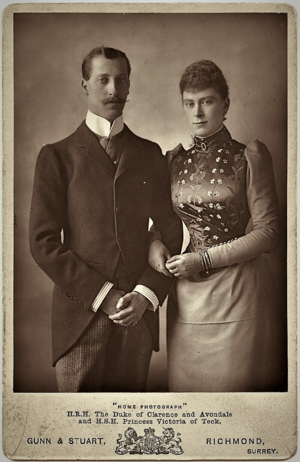
In 1889, Albert Victor's grandmother Queen Victoria expressed her wish that he marry his paternal cousin Princess Alix of Hesse and by Rhine, who was one of her favorite granddaughters. In Balmoral Castle, he proposed to Alix, but she did not return his affections and refused his offer of engagement. He persisted in trying to convince Alix to marry him, but he finally gave up in 1890 when she sent him a letter in which she told him "how it grieves her to pain him, but that she cannot marry him, much as she likes him as a Cousin." In 1894, she married Tsar Nicholas II of Russia, another of Albert Victor's cousins.
After her proposed match with Alix fell through, Victoria suggested to Albert Victor that he marry another first cousin, Princess Margaret of Prussia. On 19 May 1890, she sent him a formal letter in which she expressed her opinions about Margaret's suitability to become Queen: "Of the few possible Princess (for of course any Lady in Society would never do) I think no one more likely to suit you and the position better than your Cousin Mossy ... She is not regularly pretty but she has a very pretty figure, is very amiable and half English with great love for England which you will find in very few if any others." Although Albert Victor's father approved, Queen Victoria's secretary Henry Ponsonby informed her that Albert Victor's mother "would object most strongly and indeed has already done so." Nothing came of Queen Victoria's suggestion.
By this time however, Albert Victor was falling in love with Princess Hélène of Orléans, a daughter of Prince Philippe, Count of Paris, a pretender to the French throne who was living in England after being banished from France in 1886. At first, Queen Victoria opposed any engagement because Hélène was Roman Catholic. Once Albert Victor and Hélène confided their love to her, the Queen relented and supported the proposed marriage. Hélène offered to convert to the Church of England, and Albert Victor offered to renounce his succession rights to marry her.
To the couple's disappointment, her father refused to countenance the marriage and was adamant she could not convert. Hélène travelled personally to intercede with Pope Leo XIII, but he confirmed her father's verdict, and the courtship ended. When Albert Victor died, his sisters Maud and Louise sympathized with Hélène and treated her, not his fiancée Princess Victoria Mary of Teck, as his true love. Maud told her that "he is buried with your little coin around his neck" and Louise said that he is "yours in death". Hélène later became Duchess of Aosta.
By 1891, another potential bride, Princess Victoria Mary of Teck, was under consideration. Mary was the daughter of Queen Victoria's first cousin Princess Mary Adelaide, Duchess of Teck. Queen Victoria was very supportive, considering Mary ideal—charming, sensible and pretty. On 3 December 1891 Albert Victor, to Mary's "great surprise", proposed to her at Luton Hoo, the country residence of the Danish ambassador to Britain. The wedding was set for 27 February 1892.
Death
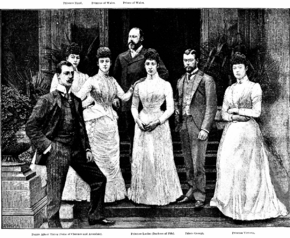
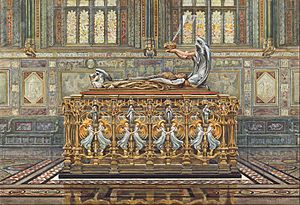
Albert Victor fell ill with influenza in the pandemic of 1889–1892. He developed pneumonia and died at Sandringham House in Norfolk on 14 January 1892, less than a week after his 28th birthday.
His parents the Prince and Princess of Wales, his sisters Princesses Maud and Victoria, his brother Prince George, his fiancée Princess Mary, her parents the Duke and Duchess of Teck, three physicians (Alan Reeve Manby, Francis Laking and William Broadbent) and three nurses were present. The Prince of Wales's chaplain, Canon Frederick Hervey, stood over Albert Victor reading prayers for the dying.
The nation was shocked. Shops put up their shutters. The Prince of Wales wrote to Queen Victoria, "Gladly would I have given my life for his". Princess Mary wrote to Queen Victoria of the Princess of Wales, "the despairing look on her face was the most heart-rending thing I have ever seen." His younger brother Prince George wrote, "how deeply I did love him; & I remember with pain nearly every hard word & little quarrel I ever had with him & I long to ask his forgiveness, but, alas, it is too late now!" George took Albert Victor's place in the line of succession, eventually succeeding to the throne as George V in 1910. Drawn together during their shared period of mourning, Prince George later married Mary himself in 1893. She became queen consort on George's accession.
Albert Victor's mother, Alexandra, never fully recovered from her son's death and kept the room in which he died as a shrine. At the funeral, Mary laid her bridal wreath of orange blossom upon the coffin. James Kenneth Stephen, Albert Victor's former tutor, refused all food from the day of Albert Victor's death and died 20 days later; he had suffered a head injury in 1886 which left him suffering from psychosis. The Prince is buried in the Albert Memorial Chapel close to St George's Chapel, Windsor Castle. His tomb, by Alfred Gilbert, is "the finest single example of late 19th-century sculpture in the British Isles". A recumbent effigy of the Prince in a Hussar uniform (almost impossible to see properly in situ) lies above the tomb. Kneeling over him is an angel, holding a heavenly crown. The tomb is surrounded by an elaborate railing, with figures of saints. The perfectionist Gilbert spent too much on the commission, went bankrupt, and left the country. Five of the smaller figures were only completed with "a greater roughness and pittedness of texture" after his return to Britain in the 1920s.
Legacy
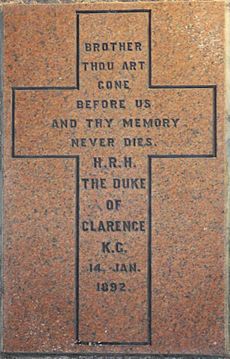
During his life, the bulk of the British press treated Albert Victor with nothing but respect and the eulogies that immediately followed his death were full of praise. The radical politician Henry Broadhurst, who had met both Albert Victor and his brother George, noted that they had "a total absence of affectation or haughtiness". On the day of Albert Victor's death, the leading Liberal politician, William Ewart Gladstone, wrote in his personal private diary "a great loss to our party". However, Queen Victoria referred to Albert Victor's "dissipated life" in private letters to her eldest daughter, which were later published.
In the mid-20th century, the official biographers of Queen Mary and King George V, James Pope-Hennessy and Harold Nicolson respectively, promoted hostile assessments of Albert Victor's life, portraying him as lazy, ill-educated and physically feeble. The exact nature of his "dissipations" is not clear, but in 1994 Theo Aronson favoured the theory on "admittedly circumstantial" evidence that the "unspecified 'dissipations' were predominantly homosexual". Aronson's judgement was based on Albert Victor's "adoration of his elegant and possessive mother; his 'want of manliness'; his 'shrinking from horseplay'; [and] his 'sweet, gentle, quiet and charming' nature", as well as the Cleveland Street rumours and his opinion that there is "a certain amount of homosexuality in all men". He admitted, however, that "the allegations of Prince Eddy's homosexuality must be treated cautiously."
Albert Victor's posthumous reputation became so bad that in 1964 Philip Magnus called his death a "merciful act of providence", supporting the theory that his death removed an unsuitable heir to the throne and replaced him with the reliable and sober George V. In 1972, Michael Harrison was the first modern author to re-assess Albert Victor and portray him in a more sympathetic light. Biographer Andrew Cook continued attempts to rehabilitate Albert Victor's reputation, arguing that his lack of academic progress was partly due to the incompetence of his tutor, Dalton; that he was a warm and charming man; that there is no tangible evidence that he was homosexual or bisexual; that he held liberal views, particularly on Irish Home Rule; and that his reputation was diminished by biographers eager to improve the image of his brother, George.
Fictional portrayals
The conspiracy theories surrounding Albert Victor have led to his portrayal in film as somehow responsible for or involved in the Jack the Ripper murders. Bob Clark's Sherlock Holmes mystery Murder by Decree was released in 1979 with "Duke of Clarence (Eddy)" played by Robin Marchal. Jack the Ripper was released in 1988 with Marc Culwick as Prince Albert Victor. Samuel West played "Prince Eddy" in The Ripper (1997), having previously played Albert Victor as a child in the 1975 TV miniseries Edward the Seventh.
Older versions of Albert Victor in Edward the Seventh are played by Jerome Watts and Charles Dance. From 1989 to 1998 Alan Moore and Eddie Campbell published the graphic novel From Hell in serialized form, which is based on Stephen Knight's theory. It was adapted into a 2001 film of the same name by the Hughes brothers. Mark Dexter portrayed both "Prince Edward" and "Albert Sickert". The story, based largely on the same sources as Murder by Decree, is also the basis for the play Force and Hypocrisy by Doug Lucie.
A pair of alternative history novels King and Joker (1976) and Skeleton in Waiting (1990), written by Peter Dickinson, are the adventures of a fictitious royal family descended from an Albert Victor who survived and reigned as King Victor I. In Gary Lovisi's parallel universe Sherlock Holmes pastiche, "The Adventure of the Missing Detective" in Sherlock Holmes: The Hidden Years, Albert Victor is portrayed as a tyrannical king, who rules after the deaths (in suspicious circumstances) of both his grandmother and father. The Prince also appears as the murder victim in the first of the Lord Francis Powerscourt crime novels Goodnight Sweet Prince, and as a murder suspect in the novel Death at Glamis Castle by Robin Paige.
In both The Bloody Red Baron (volume 2 of Anno Dracula series) by Kim Newman and the novel I, Vampire by Michael Romkey, he has become a vampire. In the former, he is the British monarch during the First World War. The Prince of Mirrors by Alan Robert Clark is a historical novel which closely follows the factual trajectory of Albert Victor's documented life, and imaginatively interweaves how that life might have been emotionally. Two DC Comics series published as part of its Elseworlds imprint feature Prince Albert ("Eddy") as a minor character: Gotham by Gaslight and Wonder Woman: Amazonia.
Titles, styles, honours and arms
Titles and styles
- 8 January 1864 – 24 May 1890: His Royal Highness Prince Albert Victor of Wales
- 24 May 1890 – 14 January 1892: His Royal Highness The Duke of Clarence and Avondale
The Duke of Clarence's full style, as proclaimed at his funeral by Garter King of Arms, was: "[the] Most High, Mighty, and Illustrious Prince Albert Victor Christian Edward, Duke of Clarence and Avondale, Earl of Athlone, Duke of Saxony, Prince of Saxe-Coburg and Gotha, Knight of the Most Noble Order of the Garter, Knight of the Most Illustrious Order of Saint Patrick".
Honours
British honours
- KG: Royal Knight of the Most Noble Order of the Garter, 3 September 1883
- KP: Extra Knight of the Most Illustrious Order of Saint Patrick, 28 June 1887
- ADC: Personal Aide-de-Camp to the Queen, 21 June 1887
- LLD: Doctor of Laws, University of Dublin, 1887
- LLD: Doctor of Laws, University of Cambridge, 1888
- Sub-Prior of the Venerable Order of Saint John of Jerusalem, 1888
Foreign honours
 Grand Cross of the Order of the Netherlands Lion
Grand Cross of the Order of the Netherlands Lion Grand Cross of the Royal Military Order of the Tower and Sword, 5 March 1885
Grand Cross of the Royal Military Order of the Tower and Sword, 5 March 1885 Grand Cross of the Royal and Distinguished Order of Charles III, with Collar, 23 January 1885
Grand Cross of the Royal and Distinguished Order of Charles III, with Collar, 23 January 1885 Order of Osmanieh, 1st Class in Diamonds
Order of Osmanieh, 1st Class in Diamonds Grand Cross of the Order of the Star of Romania
Grand Cross of the Order of the Star of Romania Knight of the Supreme Order of the Most Holy Annunciation, 8 January 1885
Knight of the Supreme Order of the Most Holy Annunciation, 8 January 1885 Grand Cross of the Order of the Southern Cross
Grand Cross of the Order of the Southern Cross

 Grand Cross of the Saxe-Ernestine House Order, 1883
Grand Cross of the Saxe-Ernestine House Order, 1883 Grand Cross of the Grand Ducal Hessian Order of Ludwig, 30 April 1884
Grand Cross of the Grand Ducal Hessian Order of Ludwig, 30 April 1884 Grand Cross of the Order of the White Falcon, 1885
Grand Cross of the Order of the White Falcon, 1885 Knight of the Order of the Elephant, 11 October 1883
Knight of the Order of the Elephant, 11 October 1883
 Knight of the Royal Order of the Seraphim, 8 January 1885
Knight of the Royal Order of the Seraphim, 8 January 1885 Knight of the Order of the Black Eagle, 8 January 1885
Knight of the Order of the Black Eagle, 8 January 1885 Grand Cordon of the Order of Leopold, 1885
Grand Cordon of the Order of Leopold, 1885
 Grand Cross of the Royal Hungarian Order of Saint Stephen, 1887
Grand Cross of the Royal Hungarian Order of Saint Stephen, 1887
Military
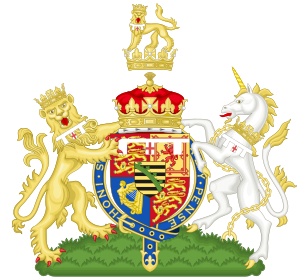
- 1877–1879: Cadet aboard training ship HMS Britannia, Dartmouth, Devon
- 1879–1880: Cadet, HMS Bacchante
- Mid, 1880–1883: Promoted to Midshipman, HMS Bacchante
- Lt, 1886–1887: Appointed Lieutenant, 10th (Prince of Wales' Own) Royal Hussars
- Capt, 1887: Promoted to Captain, 9th Queen's Royal Lancers
- Capt, 1887–1889: Captain, 3rd King's Royal Rifle Corps
- Maj, 1889–1892: Major, 10th (Prince of Wales' Own) Royal Hussars
Honorary military appointments
British
 Honorary Colonel, 4th Regiment, Bengal Infantry
Honorary Colonel, 4th Regiment, Bengal Infantry Honorary Colonel, 4th Bombay Cavalry
Honorary Colonel, 4th Bombay Cavalry Honorary Colonel, 1st Punjab Cavalry
Honorary Colonel, 1st Punjab Cavalry- Honorary Colonel, Third City of London Rifle Volunteer Corps (7th (City of London) Battalion, London Regiment) 1890–92
Arms
With his dukedom, Albert Victor was granted a coat of arms, being the royal arms of the United Kingdom, differenced by an inescutcheon of the arms of Saxony and a label of three points argent, the centre point bearing a cross gules.
See also
 In Spanish: Alberto Víctor de Clarence para niños
In Spanish: Alberto Víctor de Clarence para niños


